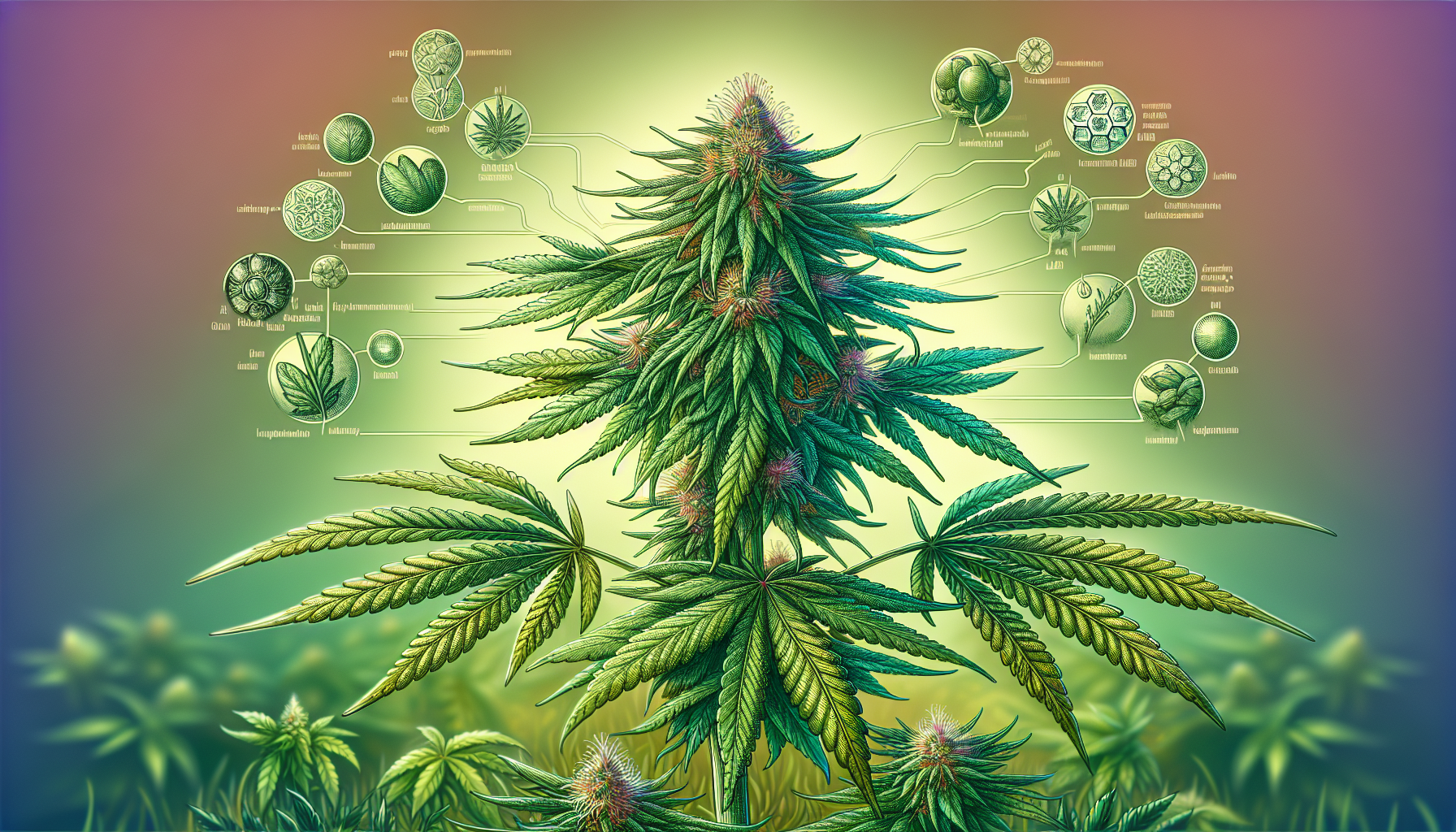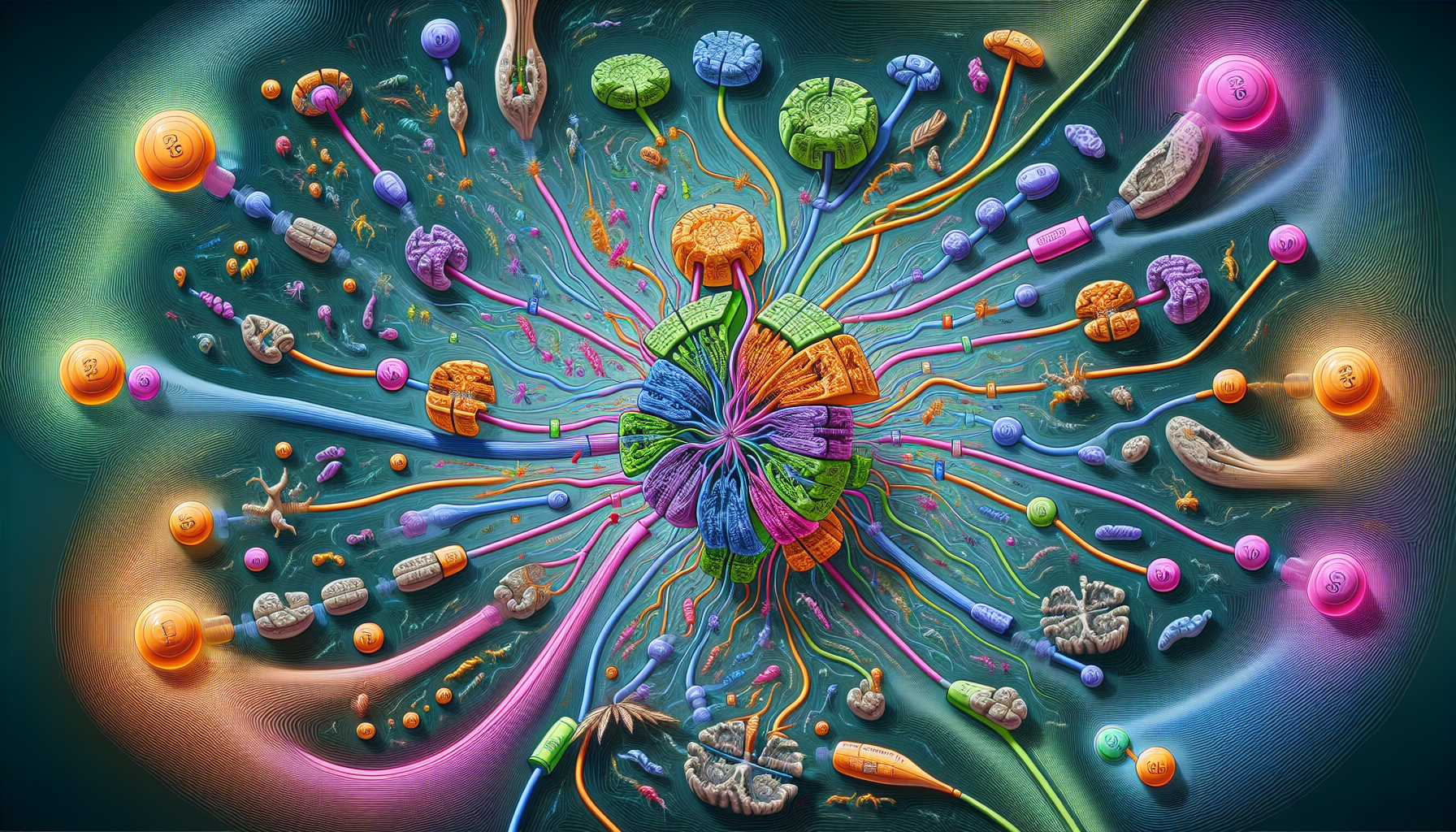What is HHC-P? Effects, side effects and differences
HHC-P is a powerful, semi-synthetic cannabinoid made by modifying HHC. It is often referred to as the king of cannabinoids due to its overwhelming potency and versatility. It does not occur naturally in hemp plants. In this article, you will learn what HHC-P is, how it differs from other cannabinoids, and what effects it has.
The most important things at a glance
-
HHC-P is a semi-synthetic cannabinoid produced by converting CBD and is considered more potent than THC, with a higher binding to the CB1 receptors. HHC-P binds to the receptors up to 31 times more strongly than THC, highlighting its superior potency.
-
The effects of HHC-P include euphoria, relaxation and stress reduction, while side effects may include dizziness, nausea and anxiety.
-
In Germany, HHC-P was classified as illegal in 2024, which significantly affects its availability and sale.
What is HHC-P?

HHC-P, also known as hydroxyhexahydrocannabinol, belongs to the group of phytocannabinoids and is a newly discovered compound that was created by modifying HHC. Interestingly, HHC-P is not believed to be found in any hemp plant in the world, but can be detected in small amounts in pollen and seeds of the cannabis plant. The chemical structure of HHC-P makes it a stable, semi-synthetic cannabinoid that is considered a hydrogenated form of CBD.
The structural similarities between HHC and THC are based on their chemical structure, which results in similar properties. All cannabinoids originally come from CBG (cannabigerol), which converts over time into over 100 different types of cannabinoids. An increased number of carbon atoms in cannabinoids such as HHC-P increases their lipophilicity and enhances the effects.
HHC-P thus brings a new dimension to the world of cannabinoids that is worth investigating further.
production of HHC-P

The production of HHC-P begins with the extraction of CBD found in hemp. This process of converting CBD to HHC-P is done through a process called hydrogenation, which converts CBD or THC into new chemical compounds. This process is crucial to creating the unique properties of HHC-P and ensuring its stability and effectiveness.
The question of whether HHC-P is synthetic will be explored in more detail in the following sections, as will the specific chemical conversion processes used to produce this interesting cannabinoid. These processes and their scientific basis are essential to fully understanding the complexity and potential benefits of HHC-P.
Is HHC-P synthetic?
HHC-P is classified as a synthetic cannabinoid, which is created in the laboratory by chemically modifying HHC. However, it is semi-synthetic, meaning it is partially derived from natural sources such as HHC. The semi-synthetic nature of HHC-P allows it to take advantage of the natural benefits of HHC while improving its chemical properties.
An interesting aspect is that HHC-P is currently a legal cannabinoid as long as it is not completely synthetic. This legal grey area makes HHC-P an exciting area of research, especially since it can be extracted from CBD, which affects its legal classification.
This semi-synthetic nature opens new avenues for the research and use of cannabinoids.
Chemical transformation processes
A key chemical process used to produce HHC-P is isomerization, which involves altering the structure of a molecule to create new cannabinoids. This process is critical to achieving HHC-P's unique properties and maximizing its effectiveness.
The science behind these chemical reactions is complex, but it offers enormous potential for the development of new cannabinoid-based products.
effects of HHC-P

HHC-P is known for its strong psychoactive effects that can produce intense psychoactive experiences. The effect is often described as very euphoric and can produce a pleasant happy high. The effects are particularly strong when taken via edibles or a vape pen. HHC-P can have the following effects:
-
euphoria
-
stress reduction
-
relaxation
-
Improved sleep
The general physical effects of HHC-P include feelings of relaxation, anti-inflammatory effects, and relief from anxiety. These effects can vary from person to person and are felt after 25-45 minutes, although the method of consumption can affect the duration of the effects.
Some reports attribute a stronger effect to HHC-P than other cannabinoids such as THCP. Compared to Delta 9 THC, HHC-P offers higher bioavailability.
binding to CB1 and CB2 receptors
The chemical structure of HHC-P includes a longer alkyl chain that improves binding to the CB1 and CB2 receptors in the endocannabinoid system. HHC-P has a binding strength that is 31 times higher than that of Delta-9-THC to the CB1 receptors. This emphasizes the high potency of HHC-P. This stronger binding ability leads to more intense effects and higher potency.
By binding to the CB1 and CB2 receptors, HHC-P acts in the endocannabinoid system and exerts its effects. This strong binding to the receptors is a key factor in the pronounced psychoactive and physical effects of HHC-P.
Comparison with THC and HHC
HHC-P and THC-P have structural similarities because both have a seven-carbon alkyl chain. Δ9-THC works in particular through its binding affinity to CB1 receptors. Compared to THC, HHC-P is estimated to be up to 33 times more active at CB1 receptors. This higher activity leads to stronger psychoactive effects, which are described as extremely potent.
HHC-P has similar properties to THC, but with a significantly higher potency. The high from HHC-P is described as being comparable to about 10 times the THC high. These differences make HHC-P a particularly interesting cannabinoid for consumers looking for more intense experiences.
Unlike HHC, HHC-P offers a stronger effect and higher bioavailability. However, similar to THC-O, which also has psychoactive effects, HHC-P is still less researched, leading to uncertainty about its exact effects. These unique properties of HHC-P open up new possibilities for use in various areas, both therapeutic and recreational.
Studies on HHC-P
Although research on HHC-P is still in its infancy, initial studies suggest that this cannabinoid may have promising potential for therapeutic applications. One study has shown that HHC-P has a higher affinity for the CB1 and CB2 receptors than THC, which could enhance its effects.
This increased binding affinity could make HHC-P an effective agent for treating pain, inflammation, and other health problems. There is evidence that HHC-P may also have neuroprotective properties, making it a potential candidate for treating neurological diseases such as Alzheimer's and Parkinson's.
Still, more studies are needed to fully understand the effects of HHC-P and confirm its safety and efficacy in medicine. Research on HHC-P is still in its early stages, but there is hope that it could be an important part of the future of cannabinoid research.
HHC-P experiences
Initial user reports indicate that HHC-P is a powerful and intense cannabinoid. Many users report a euphoric mood and a more intense experience compared to other cannabinoids. These reports suggest that HHC-P has a stronger psychoactive effect that can have both positive and negative effects.
Some users describe the effects of HHC-P as very relaxing and stress-reducing, while others report improved sleep quality. However, there are also reports of side effects such as dizziness, nausea and anxiety, especially at higher doses.
It is important to note that the effects of HHC-P may vary from person to person, so it is advisable to carefully control the dosage and work your way up slowly to avoid unwanted effects. Users should always start with a small dose and closely monitor their body's response.
Side effects of HHC-P
As with any powerful cannabinoid, HHC-P can cause both short-term and long-term side effects. The most common side effects include dizziness, nausea, and anxiety. The risk of side effects increases with higher doses of HHC-P, and its overwhelming potency should be considered when using it.
Full agonist cannabinoids such as HHC-P can cause severe side effects and can be life-threatening in the event of an overdose. These effects have no ceiling effect, which can lead to extreme side effects. There are still some unknown side effects of HHC-P that need further research.
Short-term side effects
The frequently reported short-term effects of HHC-P include dizziness, nausea and anxiety. At higher doses, symptoms such as rapid heartbeat and increased blood pressure can occur. An overdose with HHC-P Edibles also carries the risk that the effects will take a longer time to set in but will last longer.
These short-term side effects should not be underestimated, especially for first-time users. It is advisable to start with small doses and closely monitor the body's reaction to minimize unwanted effects.
Long-term risks
The long-term consequences of HHC-P use are largely unknown and require further research. There is a possibility that HHC-P is a full agonist, which can cause severe side effects and life-threatening conditions in case of overdose.
The need for further studies to confirm safety and efficacy is crucial.
Applications of HHC-P

HHC-P offers a wide range of applications, both therapeutically and recreationally. Individuals looking for new therapeutic options or alternative experiences may be interested in HHCP.
These application possibilities are explained in more detail in the table of contents of the following sections.
Therapeutic Potential
HHC-P is being studied as a potential treatment for neurological diseases such as Alzheimer's and Parkinson's. Research shows promising results in relieving pain and reducing inflammation. HHC-P's specific mode of action, including its binding to CB1 and CB2 receptors, may contribute to these therapeutic benefits. It may also prove useful in treating nausea and improving sleep quality.
Despite the promising results, there are currently too few official medical studies on HHC-P. Further studies are needed to fully confirm the safety and effectiveness of this semi-synthetic cannabinoid.
HHC-P could help with pain, anxiety and depression and thus offers great therapeutic potential.
recreational consumption
Recreational use of HHC-P is growing in popularity, particularly due to its powerful psychoactive effects. It is important to use HHC-P responsibly and always in a safe and familiar environment to minimize unwanted side effects. Use should always be done with caution, especially for first-time users, who should start with a small dose.
HHC-P can be consumed in a variety of forms, including vapes, flower, and edibles, offering different experiences. It is important to only purchase HHC-P from trusted vendors that offer quality products. This not only ensures the quality of the products, but also minimizes potential risks when consuming it.
HHC-P vs. HHC-O: What are the differences?
HHC-P and HHC-O are both cannabinoids, but they differ in how they are produced, their effects, and their uses. HHC-P is a semi-synthetic cannabinoid produced through a chemical reaction called hydrogenation, while HHC-O is a natural cannabinoid found in the cannabis plant.
The effects of HHC-P are more intense and longer lasting than those of HHC-O. HHC-P has a higher affinity for the CB1 and CB2 receptors in the human body, which may enhance its effects. This stronger binding ability leads to more intense psychoactive effects and higher potency.
HHC-O, on the other hand, has a milder effect and is often described as a “soft” cannabinoid. It is more suitable for consumers who are looking for a less intense experience or who are more sensitive to strong cannabinoids. Both compounds have their own benefits and can be used depending on the individual needs and preferences of the consumer.
Legality of HHC-P

The legal situation of HHC-P is complex and varies by country. In Germany, HHC-P was classified as illegal on June 27, 2024. Only experts under strict legal regulation are allowed to produce HHC-P. These new regulations have a significant impact on the availability and sale of HHC-P.
Internationally, the legal status of HHC-P is not clearly defined, leading to varying interpretations and enforcement. In many regions, research on HHC-P is restricted due to strict laws.
The international regulations on HHC-P are discussed in more detail in the following sections.
Legal situation in Germany
In Germany, HHC-P is no longer available due to new legal regulations. The legal availability of HHC-P has been lifted, making it illegal to buy HHC-P. The sale and manufacture of HHC-P are also illegal.
Interestingly, however, the possession and consumption of HHC-P are not penalized, despite its illegal availability. These regulations create a complex legal framework that affects both producers and consumers. It is important to be informed about the current legal regulations in order to avoid legal consequences.
International Regulation
Regulations on HHC-P vary considerably between countries, with many EU countries taking restrictive measures. In many regions, research on HHC-P is restricted due to strict laws. These differing regulations make international cooperation and the exchange of research results difficult.
Some countries have implemented strict controls, while others allow the use of HHC-P. These different approaches to regulating HHC-P demonstrate the complexity and the need for a clear legal framework at the international level.
Will a drug test detect HHC-P?
It is not yet fully understood whether a drug test will detect HHC-P, as there have not been any comprehensive studies on the subject. However, since HHC-P is a cannabinoid found in the cannabis plant, there is a possibility that it could be detected in a drug test.
The results of a drug test depend on many factors, including the dosage and method of administration of HHC-P. It is possible that HHC-P produces metabolites similar to THC that can be detected in standard drug tests. Therefore, users of HHC-P should be aware of the potential risks and consequences, especially if they are subject to regular drug testing.
It is advisable to educate yourself about the potential drug testing effects before consuming HHC-P and, if necessary, consider alternative cannabinoids that are less likely to be detected in tests.
Purchase and consumption of HHC-P
Purchasing and consuming HHC-P requires special caution to ensure the quality of the products and minimize potential risks.
Here are some important points to keep in mind:
-
The quality of HHC products may vary, posing potential risks when consumed.
-
It is advisable to always start with a small amount when first testing HHC products.
-
Follow the manufacturer's instructions.
By following these points, you can ensure that you consume HHC-P responsibly.
The following sections provide detailed information on where to buy HHC-P and what forms of consumption are available. This will help you make informed decisions and find the best products on the market.
Where can I buy HHC-P?
The most popular HHC-P products are HHC-P vapes and HHC-P flowers. HHC-P distillate is also very popular. When buying HHC-P, it is important to pay attention to the quality of the products. To buy high-quality HHC-P, you should check the quality and origin and avoid cheap products. Suppliers like Happy420 guarantee the quality of their products by continuously monitoring the manufacturing processes.
Purchasing from trusted suppliers is crucial to ensure that the products meet the highest quality standards and are safe to consume.
forms of consumption
HHC-P can be consumed in a variety of forms, including vapes, flower, and edibles. The effects of HHC-P are most noticeable when consumed in edibles or when using a vape pen. However, there is a risk of overdose when consuming HHC-P edibles, as the effects come on later but last longer.
These different forms of consumption offer different experiences and allow consumers to choose the method that is best for them. It is important to be informed about the different options and to consume responsibly.
Summary
HHC-P is a fascinating and potent cannabinoid that has both therapeutic and recreational uses. Its powerful effects and potential side effects make it an interesting but complex topic. Legal frameworks vary widely and it is important to stay informed of current regulations. With further research, the uses of HHC-P may become even more diverse. Stay curious and informed to fully enjoy the benefits of this exciting cannabinoid.
Frequently Asked Questions
Does HHCP get you high?
Yes, HHCP can produce similar intoxicating effects to THC because it binds to the cannabinoid receptors in the brain and can produce both highs and relaxation.
What is HHC-P?
HHC-P is a semi-synthetic cannabinoid created by modifying HHC.
Chemical Basics of HHC-P
HHC-P is a semi-synthetic cannabinoid produced through a chemical reaction called hydrogenation. This reaction changes the structure of the original cannabinoid and affects its physical, chemical and biological properties. The chemical formula of HHC-P is C28H38O2.
The chemical structure of HHC-P is similar to that of THC, but with one key variation: HHC-P has a longer alkyl chain. This longer chain increases the affinity of HHC-P for the CB1 and CB2 receptors in the human body, which can lead to a stronger and longer-lasting effect. This structural change makes HHC-P a more potent cannabinoid compared to THC.
Hydrogenation makes HHC-P more stable and resistant to oxidation and degradation, increasing its durability and effectiveness. These chemical properties make HHC-P an interesting candidate for further research and application in various fields.
How is HHC-P produced?
HHC-P is produced by the hydrogenation of CBD or THC. This process transforms the cannabinoids to produce HHC-P.
What are the effects of HHC-P?
HHC-P has strong psychoactive effects that can induce both euphoria and relaxation. These effects make it an interesting compound in the field of cannabinoids.
Is HHC-P legal?
HHC-P is illegal in Germany, so you should be careful and inform yourself about the applicable laws.

Share:
The best HHC flowers at a glance: Top quality from the HHC shops
Buy top CBN oil: quality, effects and benefits